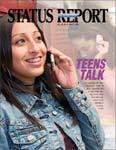Teen drivers often ignore bans on using cellphones and texting
 |
ARLINGTON, VA June 9, 2008; Teenage drivers' cellphone use edged higher in North Carolina after the state enacted a cellphone ban for young drivers, a new Institute study finds. This is the case even though young drivers and their parents said they strongly support the restrictions. Parents and teens alike believe the ban on hand-held and hands-free phone use isn't being enforced. Researchers concluded that North Carolina's law isn't reducing teen drivers' cellphone use.
The two-part study coupled researchers' observations of teenage drivers with telephone surveys of teens and their parents in the first evaluation of a cellphone law for young drivers. North Carolina's ban for drivers younger than age 18 is part of the state's graduated licensing system.
Just 1-2 months prior to the ban's Dec. 1, 2006, start, 11 percent of teen drivers were observed using cellphones as they left school in the afternoon. About 5 months after the ban took effect, almost 12 percent of teen drivers were observed using phones. Most drivers were using hand-helds. Nine percent were holding phones to their ears, while fewer than 1 percent were using hands-free devices. About 2 percent were observed dialing or texting. Cellphone use remained steady at about 13 percent at comparison sites in South Carolina, where teen driver cellphone use isn't restricted.
"Most young drivers comply with graduated licensing restrictions such as limits on nighttime driving and passengers, even when enforcement is low," says Anne McCartt, Institute senior vice president for research and an author of the study. "The hope in North Carolina was that the same would hold true for cellphone use, but this wasn't the case. Teen drivers' cellphone use actually increased a little. Parents play a big role in compliance with graduated licensing rules. Limiting phone use may be tougher for them since many want their teens to carry phones."
Parents and teens support cellphone ban: When surveyed after the cellphone restrictions took effect, teenage drivers were more likely than parents to say they knew about the ban. Only 39 percent of parents said they were aware of the cellphone law, compared with 64 percent of teen drivers. Support for the ban was greater among parents (95 percent) than teens (74 percent). Eighty-eight percent of parents said that they restrict their teenage drivers' cellphone use, though only 66 percent of teenagers reported such parental limits. About half of the teenagers surveyed after the law took effect admitted they had used their phones, if they had driven, on the day prior to the interview.
Restrictions are rarely enforced: Most parents and teen drivers agreed that police officers weren't looking for cellphone violators. Seventy-one percent of teens and 60 percent of parents reported that enforcement was rare or nonexistent. Only 22 percent of teenagers and 13 percent of parents surveyed believed the law was being enforced fairly often or a lot.
"Cellphone bans for teen drivers are difficult to enforce," McCartt notes. "Drivers with phones to their ears aren't hard to spot, but it's nearly impossible for police officers to see hands-free devices or correctly guess how old drivers are." Absent some better way to enforce them, "cellphone bans for teenage drivers aren't effective, based on what we saw in North Carolina," McCartt adds.
In both North Carolina and South Carolina, observed cellphone use was significantly higher among girls than among boys and higher when teens drove alone in vehicles rather than with friends. For example, 13 percent of female drivers and 9 percent of males were observed using cellphones in North Carolina before the law. Cellphone use was 14 percent among solo drivers and 8 percent among teens with 1 passenger. More SUV drivers than car drivers were viewed using phones.
Phone bans for young drivers are becoming commonplace as concerns mount about the contribution of distractions to teens' elevated crash risk. Seventeen states and the District of Columbia restrict both hand-held and hands-free phone use by young drivers. Six states and DC bar all drivers from using hand-helds. For a state-by-state list of cellphone laws, visit www.iihs.org.


